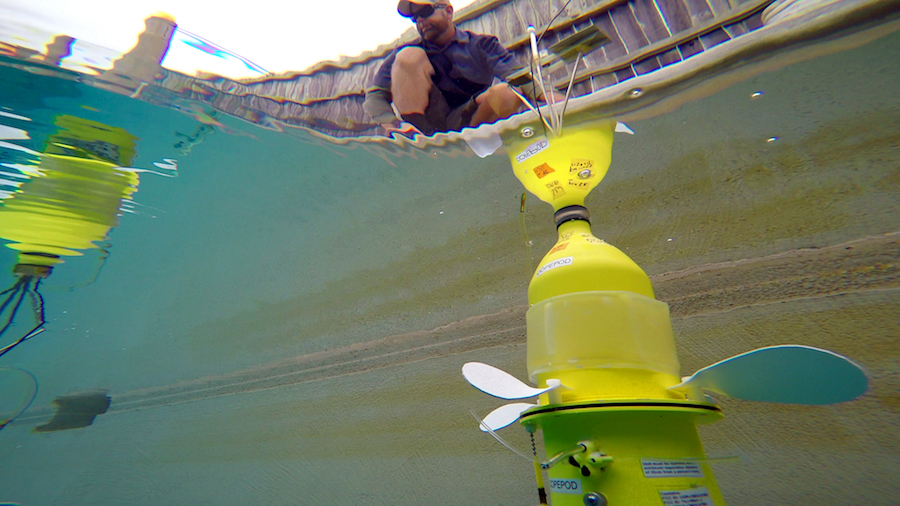
UC Davis researcher tracks movements of microscopic larvae using programmable robots, provides insight on habitat restoration, global warming
Marine larvae are early-stage marine organisms that turn into recognizable species like sea stars, crustaceans and fish. They can be as big as the head of a pin or as small as the tip of one, a combination that makes them extremely hard to track. That is, until recently, when UC Davis researchers deployed robot larvae into the open ocean.
Dr. Steven Morgan is a professor of environmental science and policy at UC Davis, and works primarily at Bodega Marine Lab. Morgan recognized that larvae have seven primary behaviors, and that those behaviors could be programed into robots, put into the ocean and tracked.
These robot larvae, made by professors Donna and Tom Wolcott at North Carolina State University, are not small animatronic robots, but instead are repurposed fire extinguishers each outfitted with a GPS, various sensors and a fan-like swimming apparatus. Unlike marine larvae, they are more than a foot long, bright yellow and easy to track.
“We have now 50 of these robots made,” Morgan said. “And at any time I might take three of them with the same behavior and another three with a different behavior […] put them all out [in the ocean] at the same place at the same time and see where they wind up going. We do that over and over under different wind and tide conditions and in different places, and we can figure out how effective the behaviors are.”
Morgan’s results are surprising. Amidst all of the oceanic noise, 60 percent of the 45 species of marine larvae studied fully develop within 3 kilometers of the coast where they were born. Morgan attributes this to the fact that most marine larvae follow diel, or day-long, vertical migration.
Ocean currents commonly flow in opposing directions. Because larval locomotion is limited to vertical swimming, they often pass through opposing currents that push them away from and then back toward the same spots. Morgan attributes the reason larvae expend the energy to move through the water to hiding from predators.
“They come up to surface waters at night to feed when they can’t be seen,” Morgan said. “During the daytime they go deeper and so by going up and down, that kind of keeps them in one place.”
One of the implications for this research lies heavily in habitat restoration. Rick Grosberg, director of the UC Davis Coastal and Marine Sciences Institute and a professor of evolution and ecology at UC Davis, spoke about the importance of larval movement in restoring damaged habitats, especially with regards to establishing a marine protected environment.
“One response [to a damaged habitat] is ‘let’s stop fishing there and hope the population restores itself,’” Grosberg said. “Let’s say the larvae go a long way; then a population that’s healthy might be supplying babies that can reestablish the population you wiped out. But let’s say that the larvae from a population don’t go very far, they basically return to where they were born. Then relying on another population to get you started again isn’t going to work.”
Restoration of marine ecosystems is instrumental to maintaining California’s struggling fishing industries, according to Grosberg.
“The question is: do babies — larvae — move out of areas that are protected and into areas that aren’t protected to subsidize the fisheries in those [locations]? And in general, we don’t have really good answers to those questions,” Grosberg said.
In total, marine protected areas cover a little over 16 percent of all coastal waters in California.
Tom Maloney is the executive director of the California Ocean Science Trust (COST), an organization created by California legislation to bridge the gap between the government, new scientific research and local communities. COST is also involved in monitoring and evaluating California’s marine protected areas.
“What [Morgan] is doing with these robots is answering a question that’s long been contemplated,” Maloney said. “We have an understanding that the connectivity of protected areas in terrestrial settings is very important. The connectivity of our marine protected areas with places where […] breeding is occurring and the larvae are starting out is also an important component of how effective our network of 124 marine protected areas is performing.”
In general, Maloney said that research in aim of understanding ocean interconnectedness will become increasingly important, especially for dealing with problems that have yet to arise from global warming and ocean acidification.
Written by: Meral Basit – science@theaggie.org



